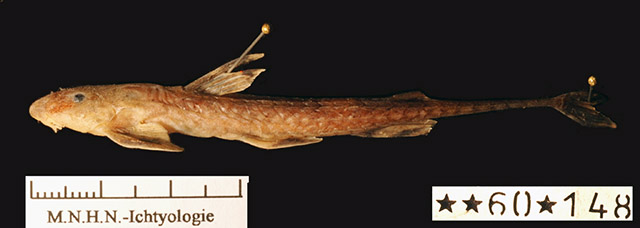|
Dorsal spines (total): -0; Dorsal soft rays (total): 7; Anal spines: 2; Anal soft rays: 7-9. Diagnosis: pectoral-fin tips not reaching to pelvic-fin bases; pelvic-fin insertions placed behind a vertical line from last dorsal-fin ray; snout long, its length over 55% of head length; posterior nostrils separated from orbits by a distance about equal to orbit width and not separated by bony crest; humeral process pointed; branchiostegal membrane with a shallow ventral invagination; width of occipital process comprised from 3.5-6 times in its length (Ref. 57128).
Description: body slightly depressed anteriorly, narrower towards caudal fin; head depressed and obtusely pointed, snout with an indistinct median bony crest; posterior nostrils slightly closer to eyes than anterior nostrils to snout tip; eyes placed dorsally, widely separated and flanked by a supraorbital bony crest; mouth small and inferior, lower lip with a median fold; barbels short, stout and verrucose, the maxillary pair with a broad basal membrane; branchiostegal membrane curved and weakly notched ventrally; supraorbital process minute, located at a short distance from dorsal-fin base; some additional bony processes present between the humeral and supraoccipital ones; dorsal fin triangular, positioned entirely ahead of pelvic fins, its simple anterior ray the longest and flexible; pectoral and pelvic fins well developed, their principal ray broad and filamentous; pelvic-fin tips falling short of anal-fin base; anal fin with 2 spines and 7 or 8 branched rays, adipose fin small, and triangular, placed above posterior part of anal fin and preceded by a short bony crest; caudal peduncle long and very thin, encased by bony plates; caudal fin small and triangular, with a semilunar posterior margin; a series of 24-26 bony plates on either side of back, from dorsal fin to caudal peduncle; a second series of 19 or 20 bony plates on either side of belly, between pelvic fins and caudal peduncle; 7+8 principal caudal fin rays (Ref. 57128).
Coloration: body marbled blackish-green, with 4-5 paler cross-bars on back; fins marked with a black band at base and a black cross-bar on distal half; caudal fin irregular, with longitudinal black markings on dorsal and ventral lobes (Ref. 57128). |
